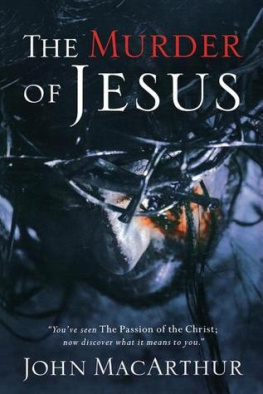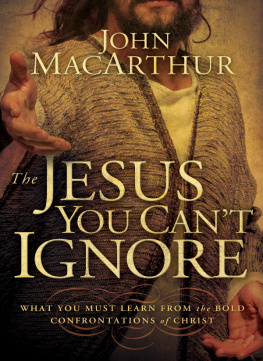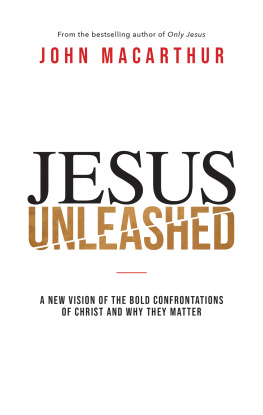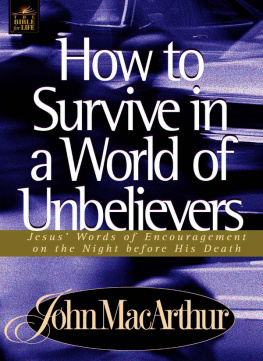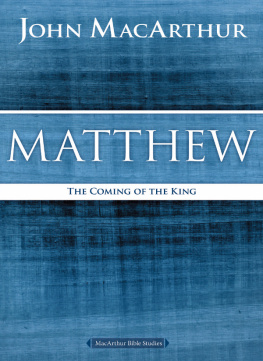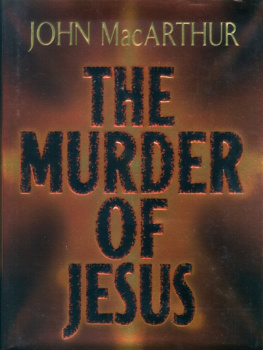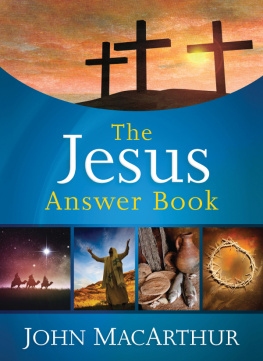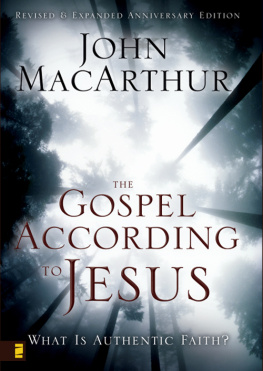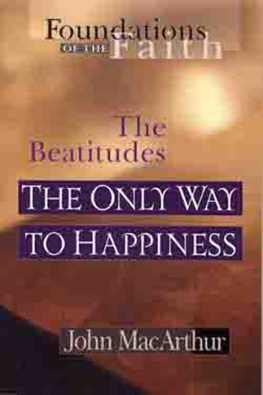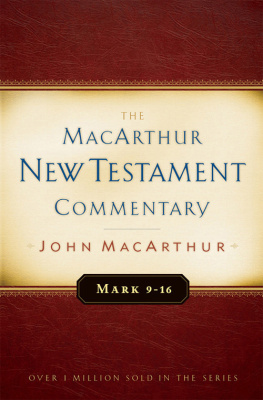2
The Last Passover
PASSOVER WAS THE FIRST FEAST of the Jewish calendar, held every year on the fourteenth day of the first month at twilight (Leviticus 23:5). It was then that every family in Israel commemorated the nations deliverance from Egypt with the sacrifice of a spotless lamb. The feast was also the oldest of all the Jewish holy days, the first Passover having been celebrated on the eve of Israels deliverance from Egypt.
Passover was immediately followed by the feast of Unleavened Bread (Leviticus 23:6). This was a week-long affair, making the entire period of feasting eight days long. The two feasts were so closely associated that the eight-day period was sometimes called the Passover and sometimes called the Feast of Unleavened Bread. (The New Testament itself sometimes uses the terms interchangeably, echoing the common parlance.) But in technical terms, Passover refers to the fourteenth of Nisan (first month of the Jewish calendar), and the Feast of Unleavened Bread refers to the remaining seven days of the feast season, which ended on 21 Nisan.
Four days prior to Passover, on 10 Nisan, each family in Israel was to select a spotless sacrificial lamb and separate that lamb from the rest of the herds until Passover, when the lamb was to be slain (Exodus 12:3-6). During that final week before His crucifixion, Jesus Himself would undoubtedly have done this with His disciples, selecting a lamb on Monday of that week.
Remember, historical records of Jesus time indicate that as many as a quarter-million lambs were slain in a typical Passover season, requiring hundreds of priests to carry out the task. Since all the lambs were killed during a two-hour period just before twilight on 14 Nisan (Exodus 12:6), it would have required about six hundred priests, killing an average of four lambs per minute, to accomplish the task in a single evening. Tradition permitted no more than two men to bring a lamb to the temple for sacrifice, and after each lamb was slain, it was to be immediately taken home and roasted. Even so, the temple mount would have been densely crowded while the lambs were being slain, with as many as half a million people moving through the area in a two-hour span.
The Jews of Jesus day had two different methods of reckoning the calendar, however, and this helped alleviate the problem. The Pharisees, as well as the Jews from Galilee and the northern districts of Israel, counted their days from sunrise to sunrise. But the Sadducees, and people from Jerusalem and the surrounding districts, calculated days from sundown to sundown. That meant 14 Nisan for a Galilean fell on Thursday, while 14 Nisan for the inhabitants of Jerusalem fell on Friday. And thus the slaughter of the lambs could take place in two two-hour time periods on successive days, thereby easing the work of the priests somewhat. About half the lambs could be killed on Thursday, and the other half were killed on Friday.
(That twist in the chronology explains why Jesus and His disciplesall Galileans, except for Judasate the Passover meal on Thursday evening in the Upper Room, yet John 18:28 records that the Jewish leadersall residents of Jerusalemhad not yet celebrated Passover on the following day when Jesus was taken to His trial in the Praetorium. It also explains why John 19:14 indicates that Jesus trial and crucifixion took place on the day of Preparation for the Passover.)
Still, the amount of blood resulting from all those sacrifices was enormous. The blood was permitted to flow off the steep eastern slope of the temple mount and into the Kidron Valley, where it turned the brook bright crimson for a period of several days. It was a graphic reminder of the awful price of sin.
Of course, all that blood and all those animals could not actually atone for sin. For it is not possible that the blood of bulls and goats could take away sins (Hebrews 10:4). The lambs only symbolized a more perfect sacrifice that God Himself would provide to take away sins. That is why John the Baptist looked beyond those animal sacrifices and pointed to the true Lamb of God who takes away the sin of the world (John 1:29). The full meaning of that prophecy was about to be unveiled.
Early on that Thursday the disciples began their preparation for the Passover Seder. Now on the first day of the Feast of the Unleavened Bread [here Matthew was employing the common colloquialism that combined the two great feasts] the disciples came to Jesus, saying to Him, Where do You want us to prepare for You to eat the Passover? (Matthew 26:17).
It is evident from Matthews account that Jesus had already prearranged many of the details for the evening. With so many visiting Israelites coming annually to Jerusalem for the feast, it was common for the citys inhabitants to keep rooms that they let out so that visitors could have a private place to eat the Passover meal with friends and family. Jesus had evidently arranged for the use of one such venue for Himself and the disciplesan upper room, probably made available by someone whom Jesus knew and who in turn was a believer in Jesus, but perhaps unknown to the disciples. He is never identified by name in any of the gospel accounts. In any case, Jesus had evidently made these arrangements secretly, to avoid having it known in advance where He would be that evening with the disciples. (If Judas had previously known the location of the Last Supper, it would have been a simple matter for him to reveal to the Sanhedrin where they could find Jesus. But it was necessary in the plan of God for Him to celebrate the Passover with His disciples before His betrayal.)
Many preparations needed to be made. Not only would the lamb need to be slaughtered at the temple and then brought back for roasting, but other elements of the meal also needed to be prepared. Chief among the elements of a Passover Seder were unleavened bread, wine, and a dish made of bitter herbs. The responsibility for preparing these elements was probably divided among a few of the disciples. And the task of arranging the room and the table was already being seen to by a servant of the man who owned the upper room.
So Jesus told them, Go into the city to a certain man, and say to him, The Teacher says, My time is at hand; I will keep the Passover at your house with My disciples (Matthew 26:18). According to Mark 14:13 and Luke 22:10, Jesus told them the man they were seeking would be carrying a pitcher of water. Normally, carrying water was a womans task, so the man would be easy to identify. Jesus, who knew all things (John 16:30), knew precisely where the man would be when they found Him. This is yet another proof that He was sovereignly in control of all these events.
We learn from Luke 22:8 that it was Peter and John who were specifically assigned to find the man and help prepare the Upper Room. Mark says they were to locate the man, follow him home, and then repeat to the owner of the house what Jesus had told them. There they would find a large upper room, furnished, and prepared (Mark 14:15). They did as Jesus had directed them; and they prepared the Passover (Matthew 26:19).
There is profound significance in Jesus statement, My time is at hand; I will keep the Passover (v. 18). On several prior occasions, Peter and John had heard Him say, My time has not yet come (John 7:6)or words to that effect. His time was now at hand, the moment He had come into the world for, and He stated that fact plainly for Peter and John. He knew He had one remaining evening to spend with His disciples, and He would spend it keeping the Passover. The Greek expression translated I will keep the Passover employs a present-tense expression to express a future event (literally, I keep the Passover). Thus He underscored the absolute inviolability of the divinely orchestrated plan.
It was vital for Christ to keep this last Passover. Later that evening He would tell the disciples, With fervent desire I have desired to eat this Passover with you before I suffer; for I say to you, I will no longer eat of it until it is fulfilled in the kingdom of God (Luke 22:15-16). The events of that evening would usher in the culmination of everything all previous Passovers had prefigured. The true Lamb of God was about to be sacrificed, and this last Passover meal would therefore be rich with significance, more so than any Passover Seder ever held by the most devout of Jewish families.
Next page
